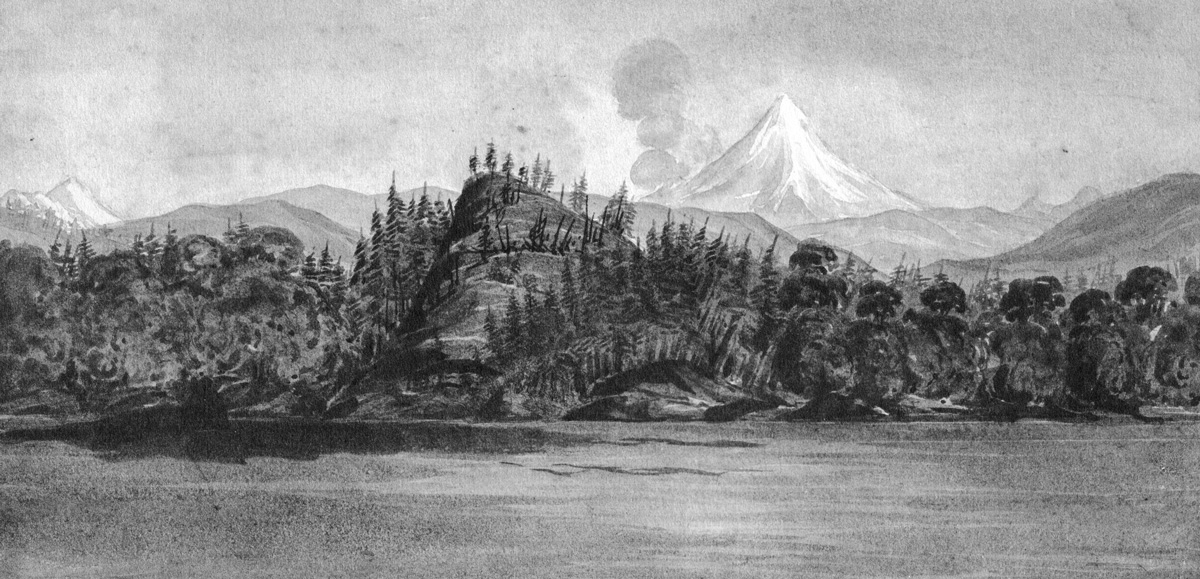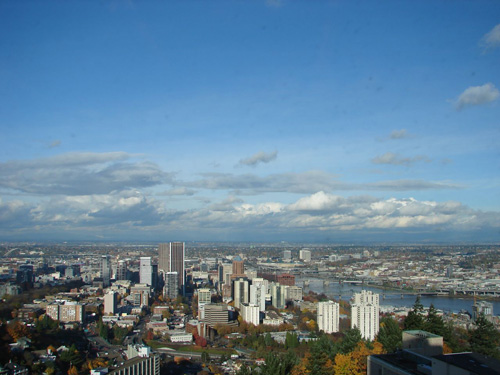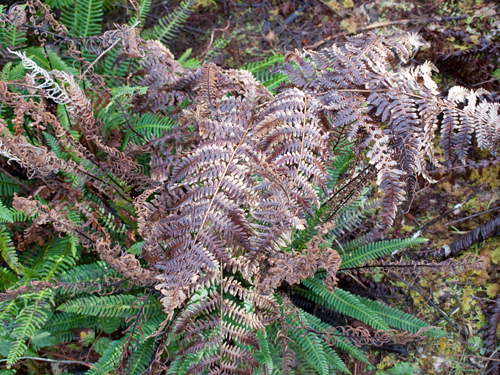As they paddle through an area packed with Multnomah and Watlala villages, they see Cascade Mountain snow peaks, fertile land, and the best prospect for a large settlement west of the Rocky Mountains. They camp on an island between present Portland, Oregon and Vancouver, Washington.
An Unusual Custom
by Yellowstone Public Radio[1]Originally aired weekdays by Yellowstone Public Radio during the Bicentennial observance of 2003-2006. Narrated by Hal Hansen. Scripts by Whit Hansen and Ed Jacobson. Produced by Leni Holliman. © … Continue reading
Above: This view is southwest and was seen by the expedition members as they passed from Fanny’s Bottom to Deer Island 27 March 1806. Mt. Coffin, a traditional burial site, was removed as part of the development of the city of Longview.
Cascade Snow Peaks
we had a view of mount St. helines and Mount Hood. the 1st is the most noble looking object of it’s kind in nature. it’s figure is a regular cone. both these mountains are perfectly covered with snow; at least the parts of them which are visible.
—William Clark
Shoto Village Escort
we came to a landing place where there was Several large canoes hauled up, and Sitting in a canoe, appearantly waiting our arival with a view to join the fleet indian who was then along Side of us . . . . we landed and one of the indians pointed to the Shoto [Multnomah] village which is Situated back of Pond which lies parrelal with the river on the N E. Side nearly opposit the Clan-nah quah [Watlala] village. here we were also joined by Several Canoes loaded with the natives from the Island who Continued to accompany us untill about 4 oClock when they all returned and we proceeded on to the place the Indians Stole my Tomahawk 4th Novr. last . . . .
—William Clark
Finest Canoes
The natives of this country ought to have the credit of making the finest canoes, perhaps in the world, both as to service and beauty; and are no less expert in working them when made.
—Patrick Gass
Prospects for a Settlement
this valley would be copetent to the mantainance of 40 or 50 thousand souls if properly cultivated and is indeed the only desireable situation for a settlement which I have seen on the West side of the Rocky mountains.
—Meriwether Lewis
Western Bracken Fern
Pteridium aquilinum
Fort-to-Sea Trail, Fort Clatsop, 17 December 2010. © by Kristopher K. Townsend. Permission to use granted under the Creative Commons Attribution-Share Alike 4.0 International license.
Above: The bracken fern lay over a background of green deer and western sword ferns (Polystichum munitum and Struthiopteris spicant) Sword ferns can also go dormant in the winter months.
Noisy Ferns
Joseph feields who was also out a little above me saw several Elk and deer but killed none of them; they are very shye and the annual furn which is now dry and abundant in the bottoms makes so much nois in passing through it that it is extreemly difficult to get within reach of the game.
—Meriwether Lewis
Weather Diary
Aspect of the weather at Rise
Wind at rise
Aspect of weather at 4 O’Ck P. M. Wind at 4 OCk. P. M. cloudy S. fair after clouds S W at 10 A. M.it became fair and continued so weather moderately warm. Saw a leather winged bat the grass is about 16 Inches high in the river bottoms. the frogs are now abundant and are crying in the swamps and marshes.—
—Meriwether Lewis[2]To assist the reader, the editor of this web page has omitted the “Day of the Month” column and spelled out some abbreviations.
Notes
| ↑1 | Originally aired weekdays by Yellowstone Public Radio during the Bicentennial observance of 2003-2006. Narrated by Hal Hansen. Scripts by Whit Hansen and Ed Jacobson. Produced by Leni Holliman. © 2003 by Yellowstone Public Radio. |
|---|---|
| ↑2 | To assist the reader, the editor of this web page has omitted the “Day of the Month” column and spelled out some abbreviations. |



